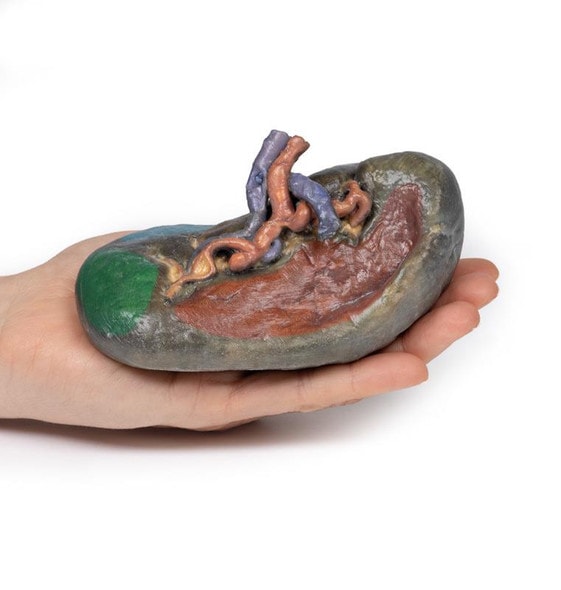Description
This 3D model preserves the deep foregut organs: the descending, horizontal and ascending duodenum, the pancreas, and the spleen. A small window in the duodenum has been opened to allow for a view of the plicae circularis within this proximal part of the small intestine (and contrasts the strong rugae development seen in the stomach; see AW 42). The head of the pancreas is preserved in its normal position within the curvature of the duodenum, and a distinct uncus can be observed at the distal margin and adjacent to the exiting of the superior mesenteric artery (already divided into its numerous named branches). Along the superior margin of the body of the pancreas, the celiac trunk has been sectioned from the descending abdominal aorta. The complete splenic artery can be observed on its tortuous route from origin to the spleen, as well as the bases of the left gastric artery and common hepatic artery. Immediately adjacent to the celiac trunk is a small part of the splenic vein, which emerges from within the capsule of the pancreas, and is in part visible in along its route near the splenic artery. A small portion of the superior mesenteric vein adheres to the posterior aspect of the pancreas, representing the course of the vessel before it would normally join the splenic and form the hepatic portal vein. The tail of the pancreas is invested in the capsule of the spleen, and obscures any branching of the splenic artery prior to entering the organ (as seen on our other spleen models in A8 and AW 34, which provides further information on the anatomy and spatial associations of this organ).
Advantages of 3D Printed Anatomical Models
- 3D printed anatomical models are the most anatomically accurate examples of human anatomy because they are based on real human specimens.
- Avoid the ethical complications and complex handling, storage, and documentation requirements with 3D printed models when compared to human cadaveric specimens.
- 3D printed anatomy models are far less expensive than real human cadaveric specimens.
- Reproducibility and consistency allow for standardization of education and faster availability of models when you need them.
- Customization options are available for specific applications or educational needs. Enlargement, highlighting of specific anatomical structures, cutaway views, and more are just some of the customizations available.
Disadvantages of Human Cadavers
- Access to cadavers can be problematic and ethical complications are hard to avoid. Many countries cannot access cadavers for cultural and religious reasons.
- Human cadavers are costly to procure and require expensive storage facilities and dedicated staff to maintain them. Maintenance of the facility alone is costly.
- The cost to develop a cadaver lab or plastination technique is extremely high. Those funds could purchase hundreds of easy to handle, realistic 3D printed anatomical replicas.
- Wet specimens cannot be used in uncertified labs. Certification is expensive and time-consuming.
- Exposure to preservation fluids and chemicals is known to cause long-term health problems for lab workers and students. 3D printed anatomical replicas are safe to handle without any special equipment.
- Lack of reuse and reproducibility. If a dissection mistake is made, a new specimen has to be used and students have to start all over again.
Disadvantages of Plastinated Specimens
- Like real human cadaveric specimens, plastinated models are extremely expensive.
- Plastinated specimens still require real human samples and pose the same ethical issues as real human cadavers.
- The plastination process is extensive and takes months or longer to complete. 3D printed human anatomical models are available in a fraction of the time.
- Plastinated models, like human cadavers, are one of a kind and can only showcase one presentation of human anatomy.
Advanced 3D Printing Techniques for Superior Results
- Vibrant color offering with 10 million colors
- UV-curable inkjet printing
- High quality 3D printing that can create products that are delicate, extremely precise, and incredibly realistic
- To improve durability of fragile, thin, and delicate arteries, veins or vessels, a clear support material is printed in key areas. This makes the models robust so they can be handled by students easily.
















